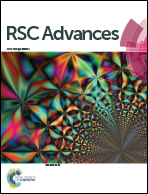Preparation and characterization of squid pen chitooligosaccharide–epigallocatechin gallate conjugates and their antioxidant and antimicrobial activities
Abstract
Chitooligosaccharide (COS) and epigallocatechin-3-gallate (EGCG) at various concentrations were used for the preparation of COS–EGCG conjugates. The highest total phenolic content (TPC), representing the amount of EGCG conjugated, was obtained for 1 wt% COS together with EGCG at 0.5 wt% (C1-E0.5-conjugate) or 1.0 wt% (C1-E1.0-conjugate) (66.83 and 69.22 mg EGCG per g sample, respectively) (p < 0.05). The 2,2-diphenyl-1-picryl-hydrazyl-hydrate (DPPH) and 2,2′-azino-bis(3-ethylbenzothiazoline-6-sulfonic acid) (ABTS) radical scavenging activities (DRSA and ARSA, respectively) and ferric reducing antioxidant power (FRAP) of all the samples showed similar trends with TPC. The C1-E0.5-conjugate had higher DRSA, ARSA, FRAP and oxygen radical absorbance capacity (ORAC) values than COS (p < 0.05). Similarly, the antimicrobial activity of COS increased when conjugated with EGCG (p < 0.05). FTIR, 1H-NMR and 13C-NMR analyses confirmed the successful grafting of EGCG with COS. Therefore, 1 wt% COS and 0.5 wt% EGCG were used for the production of a conjugate with augmented antioxidant activity, which could be used to retard lipid oxidation of fatty foods.



 Please wait while we load your content...
Please wait while we load your content...